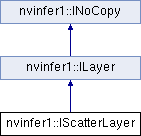A scatter layer in a network definition. Supports several kinds of scattering. More...
#include <NvInfer.h>

Public Member Functions | |
| void | setMode (ScatterMode mode) noexcept |
| Set the scatter mode. More... | |
| ScatterMode | getMode () const noexcept |
| Get the scatter mode. More... | |
| void | setAxis (int32_t axis) noexcept |
| Set the axis used by ScatterMode::kELEMENTS. More... | |
| int32_t | getAxis () const noexcept |
| Get the axis. | |
 Public Member Functions inherited from nvinfer1::ILayer Public Member Functions inherited from nvinfer1::ILayer | |
| LayerType | getType () const noexcept |
| Return the type of a layer. More... | |
| void | setName (const char *name) noexcept |
| Set the name of a layer. More... | |
| const char * | getName () const noexcept |
| Return the name of a layer. More... | |
| int32_t | getNbInputs () const noexcept |
| Get the number of inputs of a layer. | |
| ITensor * | getInput (int32_t index) const noexcept |
| Get the layer input corresponding to the given index. More... | |
| int32_t | getNbOutputs () const noexcept |
| Get the number of outputs of a layer. | |
| ITensor * | getOutput (int32_t index) const noexcept |
| Get the layer output corresponding to the given index. More... | |
| void | setInput (int32_t index, ITensor &tensor) noexcept |
| Replace an input of this layer with a specific tensor. More... | |
| void | setPrecision (DataType dataType) noexcept |
| Set the computational precision of this layer. More... | |
| DataType | getPrecision () const noexcept |
| get the computational precision of this layer More... | |
| bool | precisionIsSet () const noexcept |
| whether the computational precision has been set for this layer More... | |
| void | resetPrecision () noexcept |
| reset the computational precision for this layer More... | |
| void | setOutputType (int32_t index, DataType dataType) noexcept |
| Set the output type of this layer. More... | |
| DataType | getOutputType (int32_t index) const noexcept |
| get the output type of this layer More... | |
| bool | outputTypeIsSet (int32_t index) const noexcept |
| whether the output type has been set for this layer More... | |
| void | resetOutputType (int32_t index) noexcept |
| reset the output type for this layer More... | |
Protected Attributes | |
| apiv::VScatterLayer * | mImpl |
 Protected Attributes inherited from nvinfer1::ILayer Protected Attributes inherited from nvinfer1::ILayer | |
| apiv::VLayer * | mLayer |
Additional Inherited Members | |
 Protected Member Functions inherited from nvinfer1::INoCopy Protected Member Functions inherited from nvinfer1::INoCopy | |
| INoCopy (const INoCopy &other)=delete | |
| INoCopy & | operator= (const INoCopy &other)=delete |
| INoCopy (INoCopy &&other)=delete | |
| INoCopy & | operator= (INoCopy &&other)=delete |
Detailed Description
A scatter layer in a network definition. Supports several kinds of scattering.
- Warning
- Do not inherit from this class, as doing so will break forward-compatibility of the API and ABI.
The Scatter layer has three input tensors: Data, Indices, and Updates, one output tensor Output, and a scatter mode. When kELEMENT mode is used an optional axis parameter is available.
- Data is a tensor of rank r >= 1 that stores the values to be duplicated in Output.
- Indices is a tensor of rank q that determines which locations in Output to write new values to. Constraints on the rank of q depend on the mode: ScatterMode::kND: q >= 1 ScatterMode::kELEMENT: q must be the same as r
- Updates is atensor of rank s >=1 that provides the data to write to Output specified by its corresponding location in Index. Constraints the rank of Updates depend on the mode: ScatterMode::kND: s = r + q - shape(Indices)[-1] - 1 Scattermode::kELEMENT: s = q = r
- Output is a tensor with the same dimensions as Data that stores the resulting values of the transformation. It must not be a shape tensor. The types of Data, Update, and Output shall be the same, and Indices shall be DataType::kINT32.
The output is computed by copying the data, and then updating elements of it based on indices. How Indices are interpreted depends upon the ScatterMode.
The indices are interpreted as a tensor of rank q-1 of indexing tuples.
The axis parameter is ignored.
Given that data dims are {d_0,...,d_{r-1}} and indices dims are {i_0,...,i_{q-1}},
define k = indices[q-1], it follows that updates dims are {i_0,...,i_{q-2},d_k,...,d_{r-1}}
The updating can be computed by:
foreach slice in indices[i_0,...i_{q-2}]
output[indices[slice]] = updates[slice]
Here "axis" denotes the result of getAxis().
For each element X of indices:
Let J denote a sequence for the subscripts of X
Let K = sequence J with element [axis] replaced by X
output[K] = updates[J]
For example, if indices has dimensions [N,C,H,W] and axis is 2, then the updates happen as:
for n in [0,n)
for c in [0,n)
for h in [0,n)
for w in [0,n)
output[n,c,indices[n,c,h,w],w] = updates[n,c,h,w]]
Writes to the same output element cause undefined behavior.
Member Function Documentation
◆ getMode()
|
inlinenoexcept |
Get the scatter mode.
- See also
- setMode()
◆ setAxis()
|
inlinenoexcept |
Set the axis used by ScatterMode::kELEMENTS.
The axis defaults to 0.
◆ setMode()
|
inlinenoexcept |
Set the scatter mode.
- See also
- getMode()
The documentation for this class was generated from the following file: